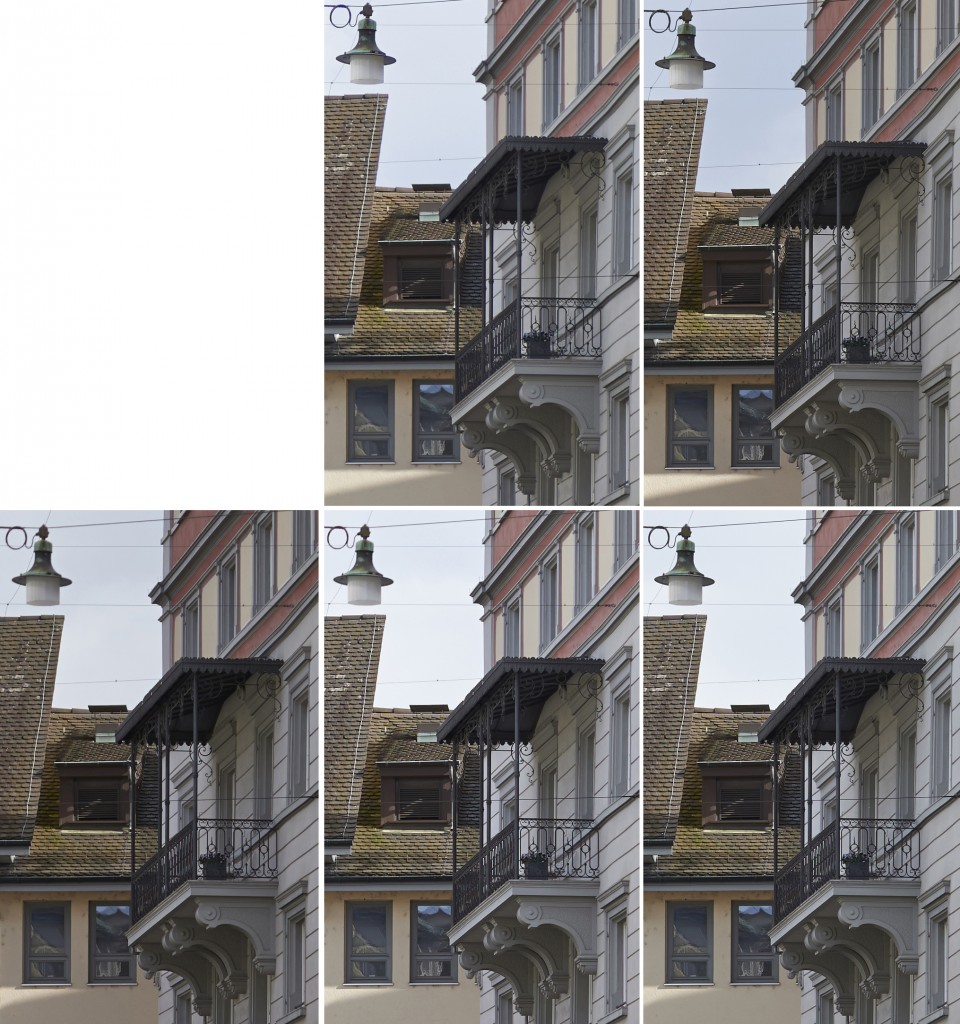
Image samples, 100% corner crops. Top: Nikon 24-70 at f/2.8 and f/5.6. Bottom: Zeiss Otus at f/1.4, f/2.8 and f/5.6. Click to enlarge.
In physics, gravitons are hypothetical elementary particles that mediate the force of gravitation in the framework of quantum field theory. For me, gravitons are real objects that mediate the drag forces into photo stores of larger cities.
During a recent trip to Zurich, Switzerland, I was dragged into the “Fotoschiff “; a fair organized by FotoPro and hosted on a boat afloat the lake. There I learned that one of the FotoPro stores had on stock a Zeiss Otus 55 f/1.4 Apo Distagon for the Nikon F mount. This gave me the opportunity to take a couple of images through the store’s door at the Rennweg. Of course, I exerted the usual shot discipline, which includes tripod mounting, focusing in live view, mirror lock up, three seconds shutter delay, and raw processing in Capture One Pro.
The full frames are devoid of any composition and are therefore omitted here. The 100% views, cropped from the upper right corner of the scene, are shown for the apertures 1.4, 2.8 and 5.6. The focal point was on the tiles of the roof, which are a good subject for testing the micro contrast and tonal rendering of lenses. The white balance was fixed to the same value and no additional sharpening was applied in the raw processor.
The results confirm the Otus hype on the Internet forums. With 12 lens elements in 10 groups, weighing in at nearly one kilogram, the lens lives up to its expectations. It is sharp to the corners already wide open; stopped down you gain a bit of micro contrast and of course depth of field. The micro contrast and tonal rendering gives the images the punch and crispiness often referred to as the “Zeiss look”. The fast transition between the in- and out-of-focus planes (notice the subject isolation of the roof tiles and the lamp at f/2.8) yields a three-dimensionality that is otherwise reserved for medium format shooters.
However, the Nikon lens I had for comparison was the 24-70 f/2.8 zoom lens, which is an unfair fight in view of the superior image quality of the manual focus, Nikon 45 PC-E (tilt/shift) lens that I had left sitting at home. The image taken with the Otus shows a distinct moiré pattern in the balustrade. Reduced moiré using the zoom lens suggests that the Otus matches the resolving power of the D800E’s sensor, while the 24-70 does not quite; it acts like a light blurring filter. Do not interpret this statement as badmouthing of the professional Nikon zoom lenses, though. These are indeed very fine lenses that I enjoy using a lot.
The build quality of the Otus is most certainly at the highest level; I would consider it on par with the professional Nikon zooms, more solid than the PC-Es, and in a different league of the 50 f/1.4 and f/1.8 lenses. On the downside, the lens hood of the Otus does not lock into place and cannot be mounted in reverse direction. I am also not sure about the aging of the sleek metal surfaces and the rubber on the focus ring, these surfaces are far too easily dinged and scratched. The focus ring has a very small thread pitch for very precise adjustment and turns smoothly with just enough resistance to stay put.
I was tempted to take a deep breath and pull out my credit card for a steep 4000 Stutz (Swiss German for Swiss Franks, 1 CHF ~ 1 $ US). But finally I decided against it because of the lack of autofocus. This decision is partially due to the camera as well: The mediocre focussing screens of modern DSLRs hamper manual focussing; also the focus indicators are not precise enough for the high-resolution sensors. Split-image focus screens are available from third party manufacturers but may cause alignment problems and revoke the Nikon warranty.
Focusing in live view is therefore the only sensible option for the use of the Otus, but requires the camera be mounted on a tripod. According to the specifications, even the D810 successor to the D800/D800E does not support focus peeking in live view, which would be a great option for precise focusing of the Otus and the use of tilt/shift lenses.
When speed is not the key (and f/1.4 not required/useful) as, for example, in landscape and architectural photography, the Otus must compete with the PC-E lenses not only for resolution and micro contrast but also in view of flare resistance and diffraction limits at a desired depth-of-field. Only a shoot-out of these lenses, and possibly the highly appraised Sigma 50 f/1.4 Art, would deserve to be denoted a review. But this is definitely on my schedule for the next visit to Calumet in Munich.
In the meantime, the Otus remains a graviton in the showcase.